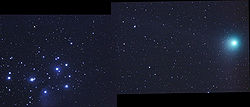- Comet Machholz
-
Not to be confused with 96P/Machholz or 141P/Machholz 2.There are five other long-period comets named Machholz: C/1978 R3 (a.k.a. 1978 XIII, 1978l), C/1985 K1 (a.k.a. 1985 VIII, 1985e), C/1988 P1 (a.k.a. 1988 XV, 1988j), C/1992 N1 (a.k.a. 1992 XVII, 1992k) and C/1994 T1 (a.k.a. 1994 XXVII, 1994r).
C/2004 Q2 (Machholz) 
Comet Machholz in February 2005Discovery Discovered by: Donald Machholz Discovery date: 2004 Alternate designations: Comet Machholz Orbital characteristics A Epoch: 2453415.5 (February 14, 2005) Aphelion distance: ~1070 AU[1] Perihelion distance: 1.205 AU Semi-major axis: ~537 AU[1] Eccentricity: 0.9995 Orbital period: 12,500 yr[1] Inclination: 38.6° Last perihelion: January 24, 2005 Next perihelion: unknown Comet Machholz, formally designated C/2004 Q2, is a long-period comet discovered by Donald Machholz on August 27, 2004.
It reached naked eye brightness in January 2005. Unusual for such a relatively bright comet, its perihelion was farther from the Sun than the Earth's orbit.
Contents
Period
Given the orbital eccentricity of this object, different epochs can generate quite different heliocentric unperturbed two-body best-fit solutions to the aphelion distance (maximum distance) of this object. For objects at such high eccentricity, the Suns barycentric coordinates are more stable than heliocentric coordinates. Using JPL Horizons the barycentric orbital elements for epoch 2011-Jan-01 generate a semi-major axis of 537 AU and a period of approximately 12,500 years.[1] This gives it a barycentric orbital period just a little larger than Sedna.
Image
See also
- 96P/Machholz (a.k.a. 1986 VIII, 1986e, 1991 XII)
- 141P/Machholz 2 (a.k.a. 1994 XXVI, 1994o)
- C/1992 F1 (a.k.a. 1992 X, 1992d), Comet Tanaka-Machholz
- C/1994 N1 (a.k.a. 1994 XX, 1994m), Comet Nakamura-Nishimura-Machholz
References
- ^ a b c d Horizons output. "Barycentric Osculating Orbital Elements for Comet C/2004 Q2 (Machholz)". http://ssd.jpl.nasa.gov/horizons.cgi?find_body=1&body_group=sb&sstr=C/2004+Q2. Retrieved 2011-02-03. (Solution using the Solar System Barycenter and barycentric coordinates. Select Ephemeris Type:Elements and Center:@0)
External links
Categories:- Comets
- Astronomical objects discovered in 2004
Wikimedia Foundation. 2010.

